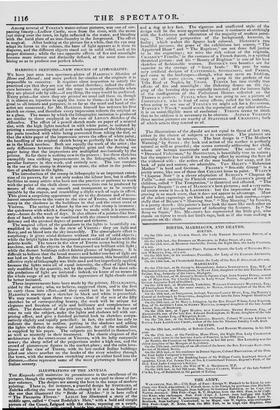HARDING'S SKETCHES—NEW PROCESS OF LITHOGRAPHY.
WE have just seen two specimen-plates of HARDING'S Sketches at Home and Abroad ; and more perfect fac-similes of the originals it is
impossible to conceive. It requires close inspection to satisfy the practised eye that they are not the actual sketches ; indeed the differ- ence between the original and the copy is scarcely discernible when they are placed side by side,—if any thing, the copy would be preferred. Every print—for since they are printed we must call them so, though it is almost an, injustice to apply the term to them—is in fact an ori- ginal to all intents and purposes, in so far as the mind and hand of the
artist are concerned ; for Mr. HARDING himself has redrawn his first sketch on stone, and therefore every impression reflects the original as
in a glass. The means by which the lithographic imitation is produced are similar to those employed in the case of I.Ewis's Sketches If the Alhambra. The effect of a pencil sketch made on paper of a neutral tint, with the high lights touched in with white paint, is imitated by printing a corresponding tint all over each impression of the lithograph ; the parts touched with white being prevented from taking the tint, so that the white paper of the impression serves the office of white paint ; the handling of the original sketch being as perfectly like in the white as in the black touches. Both are equally the work of the artist ; the only difference between the lithographic print and the drawing on paper being that the impressions are multiplied mechanically by the printer. So far there is nothing new in the process : but these sketches exemplify two striking improvements in the lithography, which are peculiar features in this work, and entirely new. The one consists in the use of the stump in drawing on stone, the other in the produc- tion of gradations in the lights. The introduction of the stump in lithography is an important exten- sion of its powers, for it not only makes the labour less, but it affords
facilities to many artists who have not the practice or patience to work
with the point of the chalk alone : moreover, tints can be produced by means of the stump, so smooth and transparent as to be scarcely imitable by the crayon, and resembling a slight wash of sepia in effect. This gives a surprising appearance of air to the distance and of trans- lucent smoothness to the water in the view of Trento, and of transpa- rency in the shadows in the buildings in that and the street scene at Vicenza. The saving of labour by the nse of the stump is immense : the quickness with which a drawing can be made with it is extraordi- nary—hours do the work of days. It also allows of a painter-like free- dom of hand, which may be combined with the utmost tenderness and delicacy and the greatest degree of power and richness. The magical effect of the gradations in the lights is beautifully ex- emplified in the clouds in the view of Vicenza: they are light and fleecy, and so blend into the sky insensibly. The atmospheric effect is surprising ; it gives atirial distance without the aid of solid objects ; while the bright lights in the foreground are as solid as if laid on with the palette-knife. The tower in the view of Trento seems basking in the sunshine, and all the objects in the foreground are brilliant with light ; while the distant buildings reflect fainter gleams of brightness. It is difficult to believe that the broad masses and bolder touches of light are not laid on by the hand. Before this improvement, this beautiful and effective style of lithography was little used and but imperfectly applied, because the lights were all of equal intensity, the effect of light being only modified by the quantity, not by the quality. Now the most sub- tile gradations of light are imitated : indeed, we know of no means in the whole range of art by which the appearance of light clouds could be better imitated.
These improvements have been made by the printer, HULLMANDEL, aided by the artist ; who, we believe, suggested them, and is the first to carry them into effect—and they could not be in better hands. HARDING'S mastery as a sketcher in black and white is proverbial. We may remark upon these two views, that if the rest of the fifty sketches be of corresponding beauty, the work will be unique for elegance and freedom of style and brilliancy and completeness of effect. The demi-tints of the printing, which are varied in hue and tone to suit the subject, make the lights and shadows tell with sur- prising effect, and give a finished pictorial look to sketches compa- ratively slightly and rapidly pencilled : in fact, the artist has only to indicate the forms in outline, putting in the shadows arid adding the lights with their due degree of intensity, for all the middle tint is supplied by his paper. The subjects are beautiful in themselves, as well as masterly in their treatment. The classic elegance of the architecture in the street-scene at Vicenza, with its lofty campanile tower; the sharp relief of the projections under a high sun, and the crowd of picturesque figures in the market-place ; and the calm love- liness of the view of Trento, with its low-roofed Italian buildings piled one above another on the banks of the river winding through the town, with the mountains stretching away on either hand into the distance,—these represent some of the most picturesque features of Italian scenery.


























 Previous page
Previous page